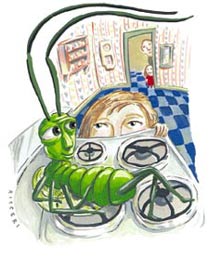
The big news last night was that a really large bug was available for viewing in the kitchen. When I got there, my husband and my older daughter were staring.
"I think it's hanging out on the stove for the warmth," Eric said.
Coco thought it was disgusting.
Then they left the room, because in this house I am the disposer of bugs. Not that I'm one of those tender-hearted lovers of all animal life. Not because I attach cute personalities or human emotions to insects. It's just that lately, I consider each bug on a case-by-case basis.
The bug on the stove was about 3/4-inch long, brown, and papery in texture. Its hind legs were much bigger than the ones in front. Its antennae waved slowly, and its exoskeleton seemed unnaturally dry. It didn't look like any bug in my garden guide. With some relief, I noted that it showed no signs of suddenly leaping up in my face. I don't like the sudden movements of bugs any more now than I did when I was a 6-year-old, easily grossed out.
The bugs of my childhood included crickets, whose sudden leaps terrified me; fist-sized arachnids known as "garden spiders"; smaller spiders, which I admired for their grace and craftsmanship; and a female praying mantis that my mother snatched with bacon tongs and placed in a can next to my father, who was napping on the couch. When he woke up, she yelled, "Surprise!" (Less than a year later, they divorced.)
My young adult years vis-a-vis bugs were Genghis Khan-like -- looting and pillaging to prove that I was not afraid of anything. The defining moment took place in the Arizona desert, where I was spraying primer paint onto a motorcycle's gas tank, and a 3-inch flying cockroach dropped onto my back from a tree.
Enraged, I sprayed him with a silver coat of primer, then trapped him under a can. I slipped a spatula beneath the can, transferred the whole assembly to the stove, and roasted the cockroach alive. It was very disconcerting -- the smell was delicious, enough to put me off ever torturing a bug again.
Which is not to say I did not kill. Every gardener knows that horrible moment when a favorite plant is discovered literally crawling with the wrong kind of insect life. You're furious -- who are these bugs, and why did they all attack? You must act immediately! So you read of solutions, woefully ineffective: Rinse with a hose, although the bugs seem to find this refreshing. Or handpick! One million microscopic marauders!
I began to amass insecticides whose contents are never supposed to land anywhere except on the bugs themselves. Most are very effective, in ways that only become horrifying over time. I never used to label myself an organic gardener, but one day not long ago, I looked down the slope from where I was shaking killer dust from a can, like so much lethal parmesan, and saw that it led directly into my town's watershed. Then a couple of dogs ran by, and I knew that it wouldn't be long before a small child did, too. It was over between me and the serious weapons of bug warfare.
Now I'm deep into the study of companion plants, dormant oil, sticky sheets of yellow paper, and accepting loss, because my garden looks rattier than it did in the chemical days. All this is no big surprise.
What is surprising is the tiny prick of interest I feel now when contemplating a bug. Consider a ladybug, whose life cycle includes three amazingly different stages -- as if I, on my journey from birth to death, were to become first a chicken egg, then a woman, and finally a toaster. Consider a spider. When I'm called on to remove spiders from my daughters' rooms, I no longer smush them with a Kleenex. Instead, I transport them somewhere safer and more productive. No girls under the age of 12 need to know, but sometimes that place is still inside the house.
And what of last night's bug on the stove, whose purpose -- harmful or benign -- is not yet clear? Catch and release, I decided. It crawled onto the back of my hand, and then, once I had walked into the cold, clear night, back off it.
You might as well live, I thought.
Robin Chotzinoff is the author of People with Dirty Hands (Harcourt Brace, 1997).
Illustration by David Ricceri